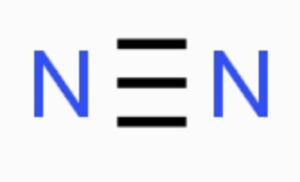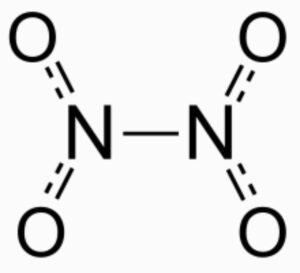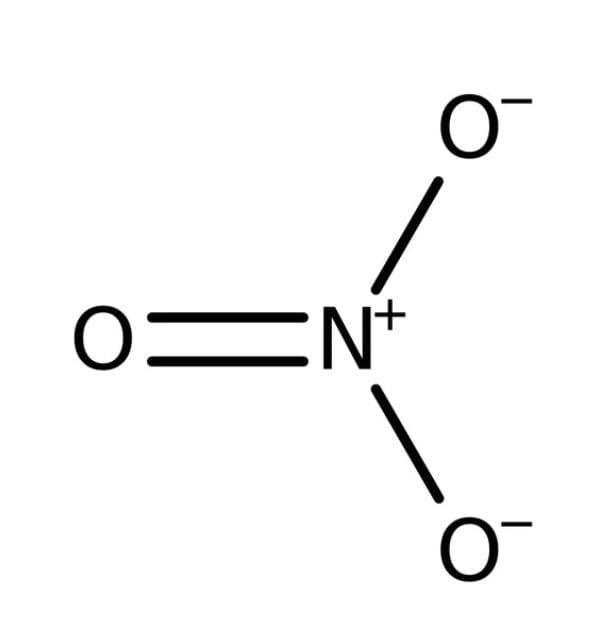In this article, we shall see 4 nonpolar covalent bond examples.
Nitrogen (N₂)
As we know Nitrogen is discovered by the renowned scientist Daniel Rutherford ( year 1772) . He obtained it by removing carbon dioxide from the products of breathing animals in closed space.
Occurrence
Elementary nitrogen constitutes three-fourths of air by mass or four-fifths by volume. Also found in KNO3 form ( quite abundant) , NaNO3various salts of ammonia. As we know Nitrogen is a very crucial element for us either we take it directly or indirectly. By plants or animals as source .

Image Credit : Chemspider
Preparation of Nitrogen
Nitrogen is conveniently prepared in the laboratory by the following methods :
(a) By heating a Solution containing Ammonium and Nitrite Ions
A solution containing equivalent amounts of ammonium chloride and sodium nitrite is warmed in a round bottom flask fitted with a thistle funnel and delivery tube. Nitrogen gas is evolved and is collected over water.

(b) By Oxidation of Ammonia.
Nitrogen is also obtained by oxidation of ammonia with red hot copper oxide or chlorine. In each case hydrogen is removed and nitrogen set free.
(c) Other Methods.
Nitrogen is also formed in a number of other reactions, the more important of which are given below :
(i)Ammonium dichromate ( usually red color crystals ) when are heated give out light ( flashes) and thus required substance is formed ( Nitrogen is left behind.

The reaction is employed for the demonstration of the eruption of volcano. For this purpose, a heap of ammonium dichromate is ignited by touching the top with a hot wire (volcano experiment).
(ii) Nitrogen is also evolved when urea is heated with an acidified solution of a nitrite.

(iii) In the presence of an alkali, sodium hypobromite, NaOBr, liberates nitrogen from ammonium salts or urea.
(iv) Very pure nitrogen is obtained by heating sodium azide, NaN₃, when it decomposes into its elements.

Process.
Carbon dioxide is compressed ( at 200 atm pressure) after that it is cooled by the process of passing it through a pipe which is surrounded by water ( cold ) . This air(which is cold as well as compressed) is made to pass through spiral followed by Joule- Thomsan effect.
This cool air passes up surroundings the spiral pipe and cooling down the coming air there in. This cooled air passes up surrounding the spiral pipe the coming air therein. Furtehr cooling takes place by expansion. The upgoing air is compressed once again and recirculated.
Nitrogen and oxygen are manufactured by the fractional evaporation of this liquid air by Claude’s process given below :
When a cold compressed gas is allowed to do some external work, e.g., pushing the piston of a gas engine (adiabatic expansion), it falls in temperature (cf. Joule-Thomson effect where in work is done against intermolecular forces).
Process.
Air is filtered to remove dust particles and compressed to about 60 atmospheres all above. It is cooled to remove the heat generated on compression. The compressed air is freed from carbon dioxide by passing through a tower packed with soda-lime and then dried by passing through alumina driers. It is next passed through pipes surrounded by cold nitrogen or cold oxygen in heat exchanger.
The cold compressed air is allowed to do work in Claude’s expansion engine when it is partially liquified. High operating pressure of the order of 140-150 is used, and air at 150 atmospheres and 248 K is expanded in this way to 6 atmospheres and 103 K when it is partially liquified.
The partially liquified air is passed through a double rectification column. In the lower column, the fraction of air not previously liquified and from the liquid air at the base rise up. These gases are richer in nitrogen, i.e., the more volatile constituent.
As the upgoing gases pass into the closed space and are forced to move down through the outer pipes surrounded by liquid oxygen, nitrogen being at 6 atmospheres condenses. Some of this liquid nitrogen is removed from here and used.
The rest passes through an expansion valve and expands to 1-atmosphere pressure. Liquid nitrogen is poured at the top of the upper column. Liquid air at the base containing about 40% oxygen is also expanded to 1 atmosphere and poured near the middle of the upper column.
As the liquid falls down the fractionating column, it meets an upward stream of gases. The liquid is warmed a little as it is coming down and loses more and more of volatile constituent, nitrogen, by evaporation and gets richer and richer in oxygen. After this process the required quality (purity) Nitrogen can be obtained.
Read more about : Alkyl Halide Examples: Detailed Insights And Facts
Nitrogen Tetroxide
It is very crucial ( substance) for preparing many other compounds .

Preparation:
It can be prepared by the oxidation process (catalytic) of the compound ammonia. In the step one of preparation, oxidation of ammonia nitric (oxide) takes place.
The water in it (almost all of it) is condensed, the gases present are cooled. The obtained nitric (oxide) is now oxidized, giving out nitrogen dioxide; after this dimerization process of this obtained nitrogen dioxide takes place, giving us the desired compound nitrogen tetroxide.
Another way for preparation is by using arsenious acid (which is in the hydrated form is used) kept in tabulated (which is in the bent neck form), and nitric (acid) is added to it. This particular mixture is warmed (slightly).
The gas that is evolved is made to pass in a bottle (wash bottle) which is later dried by using calcium nitrate (which is in the anhydrous form). The entire mixture is cooled, giving us a green (dark shade) liquid, to which dry oxygen gas is pumped (in an appropriately sealed tube)—finally giving out the required product.

Properties
- Its appearance is a red-brown color (usually liquid) with not so good smell.
- It has quite a low boiling point (recorded at about 21.15 degrees Celsius), sharp melting point (recorded at about 11.8 degrees F)
- The nitrogen tetroxide molecule is planar in nature (the N-N bond length recorded to be 1.78 Å, and the N-O bond length recorded at about 1.19A degrees)
- It is diamagnetic in nature (with no unpaired electrons).
Uses.
- Nitrogen tetroxide has the ability to undergo autoionization (molecular). Many anhydrous metal (that of transition) complexes (having nitrate) are prepared:

The preparation of metal (nitrates) using N2O4 is carried out in anhydrous (condition).
Being an oxidizing agent, N2O4 is very crucial and is used in rocket propellants as it can be kept at room temperature without any hustle.
Read More about : SN1 Examples: Detailed Insights And Facts
Dinitrogen Difluoride
- It was discovered in the year 1952.
- It has the ability to exist in the cis and trans form.

Preparation:
The reaction of N, N – disfluorourea, and potassium hydroxide (concentrated solution) gives Dinitrogen Difluoride (reaction is carried out in aqueous)
One more method is the reaction of difluoramine and potassium fluoride (note that difluoramine is said to give a solid compound which is unstable in nature) upon the process of decomposition gives the required product, i.e., dinitrogen difluoride. (In place of potassium fluoride, we can also use rubidium or cesium fluoride as a substitute.
One more method by the process of photolysis (using tetrafluorohydrogen with bromine).
It can be prepared by reacting N2O4 with a mixture (metal carbonyls and carbon monoxide) at a temperature of 175 degrees Celsius.
Properties
- It is a colorless gas at a recorded molar mass of 66.01 g/mol and has a density of 2.698g/L.
- Its observed melting point is -319.0 degrees F and -172 degrees Celsius for cis and Trans types of structure, respectively.
- Its observed boiling point is -158.35 degrees F and -111.45 degrees Celsius for cis and Trans type structure, respectively.
Isomerism:
- The symmetry of the cis form is C2V, and that of the trans form is said to be C2h. The isomers are observed to be interconvertible (by the thermal process).
- The cis and trans form are separable by fractionation (carried out at quite a low temperature).
- The Trans form of nitrogen difluoride is recorded to be less stable (in terms of thermodynamics), and it is possible to store it in a glass vessel.
- About the reactivity of cis form of nitrogen, difluoride is it has the potential to attack glass in time (of two weeks) and (gives silicon tetrafluoride + nitrous oxide)
Nitrate: (NO3- )
It is considered a polyatomic ion, and the salts comprising this particular ion are referred to as nitrates.

Preparation:
-Nitric acid is a vital component in the preparation of nitrate.
-Also naturally occurring as nitratine in the earth (deposits).
-Are prepared by considering sources of nitrogen (ammonia or urea) by bacteria (nitrifying) available in nature.
-By the process of fermentation (of urine and dung)
-When lightning strikes the earth’s surface (in nitrogen-oxygen) rich atmosphere, a whole lot of oxides is produced later washed by rain from the atmosphere.
Detection
It can be detected by the method of colorimetry. Usually, estimation/detection is based on the diazotization process involving naphtylamine. Nitrates under acidic conditions diazotize sulphanilamide to occur and product coupled with N-1-naphthyl etheylinediamine dihydrochloride. (Note the first nitrate is converted into nitrate form).
Uses:
- Used in many fertilizers (in the agro-industry).
- Being great oxidization agents used in explosives
- What effects can nitrates have on our bodies?
As we know, nitrates are an essential part of our diet, but everything has to be within limits. If it is too much, or too less, both ways, it can harm us.
If we consider drinking water, the standard amount of nitrate tolerable in water is 10mg/l. Above this can pose to be dangerous.
Problems:
Which of the above substance occurs in isomer form ?
Ans Dinitrogen Difluoride
Which compound can be prepared by following Claude’s process? and Which of the above mentioned compound has the ability to undergo autoionization ?
Ans Nitrogen and Nitrogen Tetroxide
Also Read:
- Conservative force examples
- Hydrosphere examples
- Hydrogen bond examples
- Isolated system examples
- Kinetic friction examples
- External forces examples
- Examples of displacement
- Pendulum examples
- Molecules active transport examples
- Examples of wheel and axle machines
This is Sania Jakati from Goa. I am an aspiring chemist pursuing my post graduation in organic chemistry. I believe education is the key element that moulds you into a great human being both mentally and physically. I’m glad to be a member of scintillating branch of chemistry and will try my best to contribute whatever I can from my side and Lambdageeks is the best platform where I can share as well as gain knowledge at the same time.